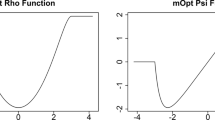Abstract
We extend the full-factor multivariate GARCH model of Vrontos et al. (Econom J 6:312–334, 2003a) to account for fat tails in the conditional distribution of financial returns, using a multivariate Student-t error distribution. For the new class of Student-t full factor multivariate GARCH models, we derive analytical expressions for the score, the Hessian matrix and the Information matrix. These expressions can be used within classical inferential procedures in order to obtain maximum likelihood estimates for the model parameters. This fact, combined with the parsimonious parameterization of the covariance matrix under the full factor multivariate GARCH models, enables us to apply the models in high dimensional problems. We provide implementation details and illustrations using financial time series on eight stocks of the US market.
Similar content being viewed by others
References
Alexander, C. (2001). Orthogonal GARCH. In C. Alexander (Ed.), Mastering risk (Vol. 2, pp. 21–38). Financial Times–Prentice Hall.
Bauwens L., Laurent S., Rombouts J.V.K. (2006) Multivariate GARCH models: A survey. Journal of Applied Econometrics 21: 79–109
Berndt E.K., Hall B.H., Hall R.E., Hausman J.A. (1974) Estimation and inference in nonlinear structural models. Annals of Economic and Social Measurement 3/4: 653–665
Bollerslev T. (1987) A conditionally heteroskedastic time series model for speculative prices and rates of return. Review of Economics and Statistics 69: 542–547
Bollerslev T. (1990) Modelling the coherence in short-run nominal exchange rates: A multivariate generalized ARCH model. The Review of Economics and Statistics 72: 498–505
Bollerslev T., Wooldridge J.M. (1992) Quasi maximum likelihood estimation and inference in dynamic models with time varying covariances. Econometric Reviews 11: 143–172
Bollerslev T., Chou R.Y., Kroner K.F. (1992) ARCH modeling in finance—a review of the theory and empirical evidence. Journal of Econometrics 52: 5–59
Brooks C., Burke S.P., Persand G. (2001) Benchmarks and the accuracy of GARCH model estimation. International Journal of Forecasting 17: 45–56
Compte F., Lieberman O. (2003) Asymptotic theory for multivariate GARCH processes. Journal of Multivariate Analysis 84(1): 61–84
Engle R.F. (1982) Autoregressive conditional heteroskedasticity with estimates of the variance of UK inflation. Econometrica 50: 987–1008
Engle R.F. (2002) Dynamic conditional correlation—a simple class of multivariate GARCH models. Journal of Business and Economic Statistics 20: 339–350
Fiorentini G., Calzolari G., Panattoni L. (1996) Analytic derivatives and the computation of GARCH estimates. Journal of Applied Econometrics 11: 399–417
Fiorentini G., Sentana E., (2003) Maximum likelihood estimation and inference in multivariate conditionally heteroscedastic dynamic regression models with Student-t Innovations. Journal of Business and Economic Statistics 21: 532–546
Goldfarb D. (1970) A family of variable-metric methods derived by variational means. Mathematics of Computation 24: 23–26
Hafner, C. M., & Herwartz, H. (2003). Analytic quasi maximum likelihood inference in multivariate volatility models. Econometric Institute Report EI 2003-21. Rotterdam: Erasmus University.
Jeantheau T. (1998) Strong consistency of estimators for multivariate ARCH models. Econometric Theory 14: 70–86
Kawakatsu H. (2006) Matrix exponential GARCH. Journal of Econometrics 134: 95–128
Lanne M., Saikkonen P. (2007) A multivariate generalized orthogonal factor GARCH model. Journal of Business and Economic Statistics 25: 61–75
Laurent S. (2004) Analytic derivatives of the APARCH model. Computational Economics 24: 51–57
Ling S., McAleer M. (2003) Asymptotic theory for a vector ARMA-GARCH model. Econometric Theory 19: 280–310
Lucchetti R. (2002) Analytical score for multivariate GARCH models. Computational Economics 19: 133–143
Mak T.K. (1993) Solving non-linear estimation equations. Journal of Royal Statistical Society B 55: 945–955
Mak T.K., Wong H., Li W.K. (1997) Estimation of nonlinear time series with conditional heteroscedastic variances by iteratively weighted least squares. Computational Statistics and Data Analysis 24: 169–178
McCullough B.D., Renfro C.G. (2000) Some numerical aspects of nonlinear estimation. Journal of Economic and Social Measurement 26: 63–77
McCullough B.D., Vinod H.D. (1999) The numerical reliability of econometric software. Journal of Economic Literature 37: 633–665
Nelson D. (1991) Conditional heteroskedasticity in asset returns: A new approach. Econometrica 59: 347–370
Shanno D.F. (1970) Conditioning on quasi-Newton methods for function minimization. Mathematics of Computation 24: 647–656
Tse Y.K., Tsui A.K.C. (2002) A multivariate generalized autoregressive conditional heteroscedasticity model with time-varying correlations. Journal of Business and Economic Statistics 20: 352–362
van der Weide R. (2002) GO-GARCH: A multivariate generalized orthogonal GARCH model. Journal of Applied Econometrics 17: 549–564
Vrontos I.D., Dellaportas P., Politis D.N. (2000) Full bayesian inference for GARCH and EGARCH models. Journal of Business and Economics Statistics 18: 187–198
Vrontos I.D., Dellaportas P., Politis D.N. (2003) A full-factor multivariate GARCH model. Econometrics Journal 6: 312–334
Vrontos I.D., Dellaportas P., Politis D.N. (2003) Inference for some multivariate ARCH and GARCH models. Journal of Forecasting 22: 427–446
Author information
Authors and Affiliations
Corresponding author
Rights and permissions
About this article
Cite this article
Diamantopoulos, K., Vrontos, I.D. A Student-t Full Factor Multivariate GARCH Model. Comput Econ 35, 63–83 (2010). https://doi.org/10.1007/s10614-009-9179-1
Received:
Accepted:
Published:
Issue Date:
DOI: https://doi.org/10.1007/s10614-009-9179-1




